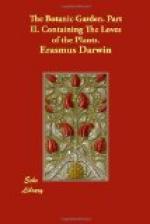Four silvan youths in crystal goblets bear The untasted treasure to the grateful fair; Pleased from their hands with modest grace she sips, And the cool wave reflects her coral lips.
375 With nice selection modest RUBIA blends,
Her
vermil dyes, and o’er the cauldron bends;
Warm
’mid the rising steam the Beauty glows,
As
blushes in a mist the dewy rose.
[Rubia. l. 375. Madder. Four males and one female. This plant is cultivated in very large quantities for dying red. If mixed with the food of young pigs or chickens, it colours their bones red. If they are fed alternate fortnights with a mixture of madder, and with their usual food alone, their bones will consist of concentric circles of white and red. Belchier. Phil. Trans. 1736. Animals fed with madder for the purpose of these experiments were found upon dissection to have thinner gall. Comment. de rebus. Lipsiae. This circumstance is worth further attention. The colouring materials of vegetables, like those which serve the purpose of tanning, varnishing, and the various medical purposes, do not seem essential to the life of the plant; but seem given it as a defence against the depredations of insects or other animals, to whom these materials are nauseous or deleterious. To insects and many smaller animals their colours contribute to conceal them from the larger ones which prey upon them. Caterpillars which feed on leaves are generally green; and earth-worms the colour of the earth which they inhabit; Butterflies which frequent flowers, are coloured like them; small birds which frequent hedges have greenish backs like the leaves, and light coloured bellies like the sky, and are hence less visible to the hawk, who passes under them or over them. Those birds which are much amongst flowers, as the gold-finch (Fringilla carduelis), are furnished with vivid colours. The lark, partridge, hare, are the colour of the dry vegetables or earth on which they rest. And frogs vary their colour with the mud of the streams which they frequent; and those which live on trees are green. Fish, which are generally suspended in water, and swallows, which are generally suspended in air, have their backs the colour of the distant ground, and their bellies of the sky. In the colder climates many of these become white during the existence of the snows. Hence there is apparent design in the colours of animals, whilst those of vegetables seem consequent to the other properties of the materials which possess them.]
With
chemic art four favour’d youths aloof
380 Stain the white fleece, or stretch the tinted
woof;
O’er
Age’s cheek the warmth of youth diffuse,
Or
deck the pale-eyed nymph in roseate hues.
So
when MEDEA to exulting Greece
From
plunder’d COLCHIS bore the golden fleece;
385 On the loud shore a magic pile she rais’d,
The
cauldron bubbled, and the faggots blaz’d;—–
Pleased
on the boiling wave old AESON swims,
And
feels new vigour stretch his swelling limbs;




